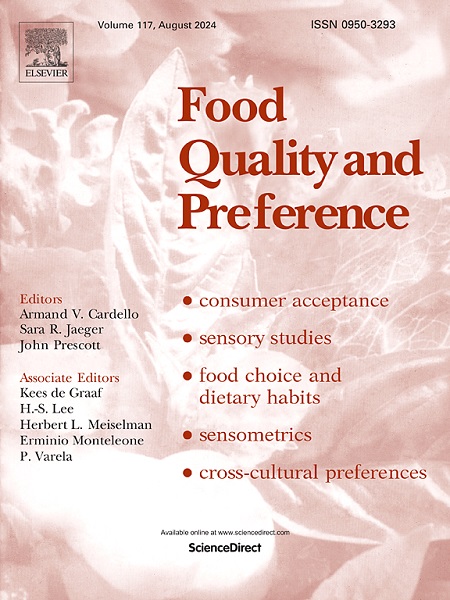跨文化消费者对精密发酵牛奶的评价:信息、个体特征和标签偏好的影响
IF 4.9
1区 农林科学
Q1 FOOD SCIENCE & TECHNOLOGY
引用次数: 0
摘要
采用替代蛋白质来源,包括精密发酵(PF)牛奶,成为可持续滋养不断增长的人口的关键战略,为传统乳制品生产提供了可行的替代方案。本研究调查了丹麦(DK)、意大利(IT)、英国(UK)和美国(US)关于动物福利、健康和环境效益的不同信息框架如何影响消费者对PF牛奶的支付意愿(WTP)。通过选择实验(CE),我们考察了不同属性的奶制品,即牛奶技术类型、动物福利信息、蛋白质类型、碳信托标签和价格,我们发现消费者普遍对PF牛奶表现出不情愿。这种不情愿因国家、所提供的利益类型和消费者特征而异。此外,潜在阶级分析确定了所有国家中三个一致的消费者群体:对传统牛奶有强烈偏好的强烈传统主义者,对替代品持开放态度但对价格敏感的轻度传统主义者,以及选择不一致(随机)的第三个群体,突出了对PF牛奶反应的共性和跨国差异。消费者对PF乳制品政策标签的偏好因国家而异,美国和意大利对这些标签与传统乳制品相似的新产品表现出更高的偏好。这些发现为在不同文化背景下有效传播PF乳制品的益处提供了有价值的方向。他们强调了在一个充斥着传统乳制品和植物性食品的市场中实现差异化和竞争的关键营销策略。最后,他们强调了重要的战略和政策影响,未来的标签和法规的PF牛奶。本文章由计算机程序翻译,如有差异,请以英文原文为准。
Cross-cultural consumer valuation of precision fermentation milk: Effects of information, individual traits, and labelling preferences
The adoption of alternative protein sources, including precision fermentation (PF) milk, emerges as a key strategy for sustainably nourishing a growing population, offering a viable alternative to conventional dairy production. This study investigates how different information framing, on animal welfare, health, and environmental benefits, affects consumer willingness-to-pay (WTP) for PF milk in Denmark (DK), Italy (IT), the United Kingdom (UK), and the United States (US). Using a choice experiment (CE) that examined milk products varying on several attributes, namely type of milk technology, animal welfare information, protein type, Carbon Trust label, and price, we found that consumers generally exhibited reluctance towards PF milk. This reluctance varied by country, the type of benefits provided, and consumer traits. Additionally, latent class analysis identified three consistent consumer segments across all countries, strong traditionalists with strong preferences for conventional cow milk, light traditionalists open to alternatives but price-sensitive, and a third group with inconsistent (random) choices, highlighting both commonalities and cross-country differences in responses to PF milk. Consumer preferences for policy labelling of PF dairy products vary by country, with the US and Italy exhibiting a higher preference for these new products labelled similarly to conventional dairy products. These findings offer valuable directions for effectively communicating the benefits of PF milk products across different cultural contexts. They highlight key marketing strategies for differentiation and competition in a market crowded with conventional dairy and plant-based options. Finally, they underscore important strategic and policy implications for future labelling and regulations of PF milk.
求助全文
通过发布文献求助,成功后即可免费获取论文全文。
去求助
来源期刊

Food Quality and Preference
工程技术-食品科技
CiteScore
10.40
自引率
15.10%
发文量
263
审稿时长
38 days
期刊介绍:
Food Quality and Preference is a journal devoted to sensory, consumer and behavioural research in food and non-food products. It publishes original research, critical reviews, and short communications in sensory and consumer science, and sensometrics. In addition, the journal publishes special invited issues on important timely topics and from relevant conferences. These are aimed at bridging the gap between research and application, bringing together authors and readers in consumer and market research, sensory science, sensometrics and sensory evaluation, nutrition and food choice, as well as food research, product development and sensory quality assurance. Submissions to Food Quality and Preference are limited to papers that include some form of human measurement; papers that are limited to physical/chemical measures or the routine application of sensory, consumer or econometric analysis will not be considered unless they specifically make a novel scientific contribution in line with the journal''s coverage as outlined below.
 求助内容:
求助内容: 应助结果提醒方式:
应助结果提醒方式:


